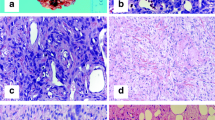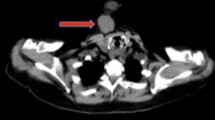Abstract
Background
Solitary fibrous tumors (SFTs) are a rare type of soft tissue sarcoma of unpredictable clinical behavior. Some clinicopathologic characteristics have also been related to patient outcome.
Methods
This study is a retrospective review of 30 patients. We analyzed the clinical course and pathological factors to predict recurrence.
Results
The mean age was 55.9 years. Forty-five percent were located in the thoracic region. The mean tumor size was 10 cm (max24). Thirty-three percent had a relapse and 20 % have died. Median time to relapse was 7.18 (1–13) years. Median overall survival (OS) was 15.5 years (0–32). On histopathologic analysis, 6 % percent had >4 mitoses, 23 % had necroses, and 36 % had atypia/pleomorphism. Forty-three percent had tumor size >10 cm. Forty-six percent had at least one characteristic of malignancy. None of this data could predict clinical behavior by itself.
Conclusions
SFT can be an aggressive disease and relapses can occur several years from diagnosis. We did not find any clinicopathologic factors that could predict the tumor behavior accurately. Nevertheless, it should be consider that we included different tumor locations and the sample size is small.




Similar content being viewed by others
References
Gengler C, Guillou L. Solitary fibrous tumor and hemangiopericytoma: evolution of a concept. Histopathology. 2006;28:67–74.
Hanau CA, Miettinen M. Solitary fibrous tumor: histological and immunohistochemical spectrum of benign and malignant variants presenting at different sites. Hum Pathol. 1995;26:440–9.
Gold JS, Antonescu CR, Hajdu C, Ferrone CR, Hussain M, Lewis JJ, et al. Clinocopathologic correlates of solitry fibrous tumor. Cancer. 2002;94(4):1057–8.
Pitluk HC, Conn J Jr. Hemangiopericytoma. Literature review and clinical presentations. Am J Surg. 1979;137:413–6.
Penel N, Yaovi Amela E, Decanter G, Robin Y-M, Marec-Berard P. Solitary fibrous tumor and so-called hemangiopericytoma. Sarcoma 2012;2012(2012):690251. doi:10.1155/2012/690251.
England MD, Hochholzer L, McCarthy MJ. Localized benig and malignant fibrous tumors of the pleura: a clinicopathologic review of 223 cases. Am J Surg Pathol. 1989;13:640–58.
Lahon B, Mercier O, Fadel E, Ghigna MR, Petkova B, Mussot S, et al. Solitary fibrous tumor of the pleura: outcomes of 157 complete resections in a single center. Ann Thorac Surg. 2012;94(2):394–400.
Fletcher CDM, Bridge JA, Hogendoorn P, Martens F. World Health Organization (WHO) classification of tumours of soft tissue and bone. Pathology and genetics. Lyon: IARC Press; 2013.
Park MS, Patel SR, Ludwig JA, Trent JC, Conrad CA, Lazar AJ, et al. Activity of temozolomide and bevacizumab in the treatment of locally advanced, recurrent, and metastatic hemangiopericytoma and malignant solitary fibrous tumor. Cancer. 2011;117:4939–47.
Guillerme F, Truntzer P, Prim N, Chenard MP, Voirin J, Noël G. Solitary fibrous tumors: case report of a late relapse. Cancer Radiother. 2011;15:330–3.
Park CK, Lee DH, Park JY, Park SH, Kwon KY. Multiple recurrent malignant solitary fibrous tumors: long-term follow-up of 24 years. Ann Thorac Surg. 2011;91:1285–8.
Mohamed H, Mandal AK. Natural history of multifocal solitary fibrous tumors of the pleura: a 25-year follow-up report. J Natl Med Assoc. 2004;96:659–62.
Oliaro A, Filosso PL, Casadio C, Ruffini E, Cianci R, Porrello C, et al. Il mesotelioma fibroso benigno della pleura. Minerva Chir. 1994;49:1311–6.
Masson EA, MacFarlane IA, Graham D, Foy P. Spontaneous hypoglicemia due to a pleural fibroma: role of insulin like growth factors. Thorax. 1991;46:930–1.
de Perrot M, Fischer S, Bründler MA, Sekine Y, Keshavjee S. Solitary fibrous tumors of the pleura. Ann Thorac Surg. 2002;74:285–93.
Mosquera JM, Fletcher CD. Expanding the spectrum of malignant progression in solitary fibrous tumors: a study of 8 cases with a discrete anaplastic component—is this dedifferentiated SFT? Am J Surg Pathol. 2009;33:1314–21.
Tapias LF, Mino-Kenudson M, Lee H, Wright C, Gaissert HA, Wain JC, et al. Risk factor analysis for the recurrence of resected solitary fibrous tumors of the pleura: a 33-year experience and proposal for a scoring system. Eur J Cardiothorac Surg. 2013;44(1):111–7. doi:10.1093/ejcts/ezs629.
Baldi GG, Stacchiotti S, Mauro V, Dei Tos AP, Gronchi A, Pastorino U, et al. Solitary fibrous tumor of all sites: outcome of late recurrences in 14 patients. Clin Sarcoma Res. 2013;3:4–11.
Magdeleinat P, Alifano M, Petino A, Le Rochais JP, Dulmet E, Galateau F, et al. Solitary fibrous tumors of the pleura: clinical characteristics, surgical treatment and outcome. Eur J Cardio Thorac Surg. 2002;21:1087–93.
Rena O, Filosso PL, Papalia E, Molinatti M, Di Marzio P, Maggi G, et al. Solitary fibrous tumors of the pleura: surgical treatment. Eur J Cardio Thorac Surg. 2001;19:185–9.
Cardillo G, Facciolo F, Cavazzana AO, Capece G, Gasparri R, Martelli M. Localized (solitary) fibrous tumors of the pleura: an analysis of 55 patients. Ann Thorac Surg. 2000;70:1808–12.
Brozzetti S, DÁndrea N, Limit MR, Pisanelli MC, De Angelis R, Carvallo A. Clinical behavior of solitary fibrous tumors of the pleura: an inmunohistochemical study. Anticancer Res. 2000;20:4701–6.
Brunnemann RB, Ro JY, Ordonez NG, Mooney J, El-Naggar AK, Ayala AG. Extrapleural solitary fibrous tumor: a clinic-pathologic study of 24 cases. Mod pathol. 1999;12:1034–42.
Demicco EG, Park MS, Araujo DM, Fox PS, Bassett RL, Pollock RE, et al. Solitary fibrous tumor: a clinicopathological study of 110 cases and proposed risk assessment model. Mod Pathol. 2012;25(9):1298–306.
Lococo F, Cusumano G, Margaritora S, Cardillo G, Filosso P, Cesario A. Tapias score for predicting recurrences in resected solitary fibrous tumor of the pleura: controversial points and future perspectives emerging from an external validation. Chest. 2015;147(3):e115–6.
Schirosi L, Lantuejoul S, Cavazza A, Murer B, Yves Brichon P, Migaldi M, et al. Pleuro-pulmonary solitary fibrous tumors: a clinicopathologic, immunohistochemical, and molecular study of 88 cases confirming the prognostic value of de Perrot staging system and p53 expression, and evaluating the role of c-kit, BRAF, PDGFRs (alpha/beta), c-met, and EGFR. Am J Surg Pathol. 2008;32(11):1627–42.
Saifuddin A, Da Costa P, Chalmers AG, Carey BM, Robertson RJ. Primary malignant localized fibrous tumors of the pleura: clinical, radiological, and pathological features. Clin Radiol. 1992;45:13–7.
Park MS, Patel S, Ravi V, Conley AP, Trent JC, Lazar AJF, et al. The role of chemotherapy in advanced hemangipeicytoma/solitary fibrous tumor. J Clin Oncol. 2011; 29, abstr 10097.
Khalifa J, Ouali M, Chaltiel L, Le Guellec S, Le Cesne A, Blay JY, Cousin P, Chaigneau L, Bompas E, Piperno-Neumann S, Bui-Nguyen B, Rios M, Delord JP, Penel N, Chevreau C. Efficacy of trabectedin in malignant solitary fibrous tumors: a retrospective analysis from the French Sarcoma Group. BMC Cancer. 2015;15(15):700.
Author information
Authors and Affiliations
Corresponding author
Ethics declarations
Conflict of interest
None.
Informed consent
Informed consent has been administered.
Rights and permissions
About this article
Cite this article
Vaz Salgado, M.A., Soto, M., Reguero, M.E. et al. Clinical behavior of solitary fibrous tumor: a retrospective review of 30 patients. Clin Transl Oncol 19, 357–363 (2017). https://doi.org/10.1007/s12094-016-1536-7
Received:
Accepted:
Published:
Issue Date:
DOI: https://doi.org/10.1007/s12094-016-1536-7




